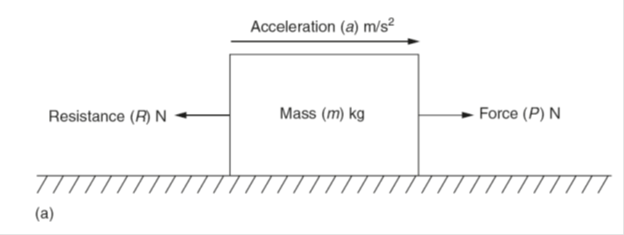Inertia and Resisted Motion
Inertia
Newton’s first law of motion states that a body remains in a state of rest or uniform motion in a straight line unless acted on by an external force. This resistance to change is referred to as the inertia of a body and the amount of inertia depends on the mass of the body. Therefore it takes a great deal more force to accelerate a fully laden heavy goods vehicle from rest than the force required to produce the same acceleration in a bicycle from rest.
Resisted motion
The following points should be carefully noted when using the expression F = ma:
- F can refer to both an accelerating force or a retarding force.
- It is often necessary to determine the value of an acceleration or a retardation, using the equations of motion considered earlier, when working out engineering calculations.
- When a force causing the acceleration of a body is resisted by a force trying to retard (decelerate) the body, the body is said to be subject to resisted motion.
Figure 1(a) shows a force P acting on a mass m against a resistance R and producing an acceleration a. The accelerating force Fa = (P – R) and Fa = ma is written P – R = ma.
Figure 1(b) shows a suspended body of mass m. Let P be the tension in the rope suspending the body:
- For motion up or down at constant speed, or when the body is at rest, the acceleration equals zero therefore the accelerating force (F) also equals zero.
- For motion downwards with acceleration a, W is greater than P where W = mg. Then
the accelerating force F = (W – P) so that (W – P) = ma.
- For motion upwards with acceleration a, F = (P – W ) so that (P – W) = ma.
Figure 1(c) shows a body on a smooth inclined plane. For this example any friction will be ignored. The component force of weight W acting down the plane = W sin θ, where W = mg (N):
- If P is greater than W sin θ, the body moves up the plane with acceleration a. The accelerating force F = P – W sin θ so that P – W sin θ = ma.
- If W sin θ is greater than P, the body moves down the plane with acceleration a. Then the accelerating force F = W sin θ – P so that W sin θ – P = ma.
Example
A body of mass of 600 kg has a resistance to motion of 400 N. Determine the total force to be applied to the body to produce a uniform acceleration of 3 m/s.
Let the total force required = P.
Then: The accelerating force F = (P – 400)
Since F = ma Then: (P – 400 N) = 600 kg × 3m/s
Therefore: P = 400 N + 1800 N = 2200N
Example
A passenger lift of mass 1500 kg starts from rest and reaches an upward velocity of 5 m/s in a distance of 10 m. Determine the tension in the lift cable if the acceleration is constant. Take g = 9.81 m/s2.
To find the acceleration use the expression (v2)2 = (v1)2 + 2as
Therefore:
52m/s = 0 + 2 m/s ×. a ×10m
So:
a = 25/(2 ×10) = 1.25 m/s2
Whilst the lift is stationary, the tension in the cable is only due to the force of gravity acting on the lift (mg) which is equal to 1500 kg × 9.81 m/s2 = 14715 N. Since the lift is accelerating upwards the tension P is greater than 14715 N.
Let P = the tension in the lift cable.
Then, the accelerating force F = P – 14715 = ma = 1500 × 1.25 m/s2.
Therefore: P = 14715 + 1500 × 1.25 = 16590 N = 16.59 kN.




